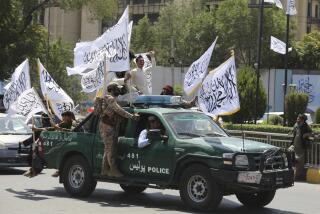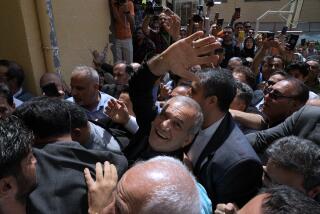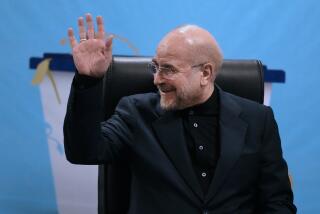Iran cracks down on women’s rights activists as leader offers his solution to sexual harassment, assault: Cover up
On the one-year anniversary of the global #MeToo movement, Iran’s Supreme Leader Ayatollah Ali Khamenei declared a solution for Western women facing sexual harassment: wear a hijab.
His statement comes amid growing unrest over the law that mandates that Iranian women wear the hijab, or headscarf, in public. In recent weeks the Iranian government has arrested several activists who have protested the law.
Khamenei took to Twitter Wednesday to give his advice, posting a two-minute-long video that accompanied his tweet, which he titled “The disaster of countless sexual assaults on Western women — including incidents leading to #Metoo campaign — and Islam’s proposal to resolve it.”
It showed women across the U.S. and Europe talk about their personal stories of harassment and included a link to an article chronicling speeches Khamenei has given over the years about the headscarf.
The remarks demonstrate Khamenei’s attempt to leverage the power of the #MeToo movement to criticize “immodest” attire that women in Western societies wear, while praising Islam as the solution.
Iran and Saudi Arabia are the two countries that require women to wear headscarves in public. Still, millions of Muslim women across the Middle East and the West choose to wear the hijab on their own.
For many, the decision to wear a headscarf goes beyond religion. It can be tied to culture, as well as fashion and politics.
In Iran, the hijab has long been politicized.
In 1928, Reza Shah Pahlavi banned the hijab to encourage Iranians to dress more like people in Europe. In 1941, the ban on hijabs was lifted for university students and professors. Shortly after the 1979 Islamic Revolution, women were forced to wear the hijab in public.
Human rights advocates this week were quick to call out the supreme leader’s hypocrisy, pointing to longstanding laws that have discriminated against women and punished those who speak out.
“[Khamenei] is trying to take the moral high ground. But within Iran, the government and hardliners’ views towards women has very much not been in the defense of women,” said Hadi Ghaemi, executive director of the Center for Human Rights in Iran, an advocacy group. “He’s been calling for policies that roll back the rights women have gained on their own. He is being opportunistic.”
The video begins with a shot of two-time Olympic gymnast Aly Raisman confronting former U.S. gymnastics doctor Larry Nassar in court over sexual assault allegations. It then jumps to various clips of well-known figures accused of sexual harassment, such as film mogul Harvey Weinstein. It also includes politicians, such as Sen. Elizabeth Warren, speaking about the plight women face.
Toward the end of the video, Khamenei is shown delivering a recent speech that suggests how the hijab protects women against harassment.
“You might have heard, a few months ago, that a large number of Western, female politicians announced, one right after another, they had been subjected to abuse, harassment or violence at times when they were working in government offices ...” Khamenei said. “By introducing hijab, Islam has shut the door on a path that would pull women towards such deviation.”
Over the last decade, women in Iran have been growing more aware about the legal and political impediments that stand in their way of achieving equality. For instance, women still need their husband’s or father’s permission before they are allowed to leave the country.
Frustrated over such discriminatory laws, a burgeoning women’s rights movement has emerged in recent months that challenges the mandate that women must wear headscarves in public.
Women have called for anti-hijab protests, and videos that show women pulling their headscarves off in public spaces have gone viral.
In response, the Islamic Republic has clamped down on dissent, arresting several women’s rights activists and human rights defenders.
In June, prominent human rights lawyer Nasrin Sotoudeh was arrested and taken to the notorious Evin Prison in Tehran. Sotoudeh, who has defended women arrested in the anti-hijab protests, started a hunger strike in August.
In September, three women’s rights advocates were arrested. Hoda Amid and Najmeh Vahedi were arrested by Iran’s Islamic Revolutionary Guard Corps a few days before they were scheduled to host a workshop, according to the Center for Human Rights in Iran. Women’s rights activist Maryam Azad was arrested a few weeks later before boarding a plane en route to Istanbul.
As President Trump imposes further sanctions on Iran, the arrests suggest how hardliners within Iran’s establishment, particularly its intelligence and security services, are gaining more control and are trying to discourage women from protesting, Ghaemi said.
“It’s a signal to activists. They are trying to intimidate them. The security enforcers are assuming more control of the domestic environment as sanctions come in. It’s a bad omen for the limited activism that was allowed in Iran up till now and signals more oppression that’s to come,” Ghaemi said.
Follow me on Twitter @melissaetehad
More to Read
Sign up for Essential California
The most important California stories and recommendations in your inbox every morning.
You may occasionally receive promotional content from the Los Angeles Times.











